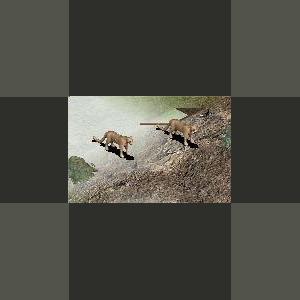About This File
The American lion (Panthera leo atrox) also known as the North American or American cave lion, is an extinct feline known from fossils.
It was one of the largest subspecies of lion to have ever existed, comparable in size to the Early Middle Pleistocene primitive
cave lion Panthera leo fossilis and was about 25% larger than the modern African lion.
The American lion is an extinct animal which originated in North America and went on to
colonize part of South America as part of the Great American Interchange. The body length
of the American lion is estimated to have been 1.6-2.5 m (5.25-8.20 feet). Thus it was
comparable in size to its close relative, the extinct lion, Panthera leo fossilis, or the
modern species of Siberian tiger, but still smaller than their contemporary competitor for
prey, the Giant short-faced bear, which was the largest carnivoran of their era.
Approximately one hundred specimens of American lions have been recovered from the La Brea
Tar Pits, in Los Angeles, so their body structure is well known. The features and teeth of
the extinct American lion strongly resemble modern lions, but they were considerably larger.
South of Alaska, the American lion first appeared during the Sangamonian (the last
interglacial). After that it was widespread in the Americas from Alaska to Peru, although
it was absent from eastern North America and peninsular Florida. As did many other large
mammals, it went extinct at the end of the Pleistocene, about 10,000 years ago. By then
the American lion was one of the abundant Pleistocene megafauna, a wide variety of very
large mammals who lived during the Pleistocene. Remains are most common in the Yukon and
from the La Brea Tar Pits.



Recommended Comments
There are no comments to display.
Create an account or sign in to comment
You need to be a member in order to leave a comment
Create an account
Sign up for a new account in our community. It's easy!
Register a new accountSign in
Already have an account? Sign in here.
Sign In Now